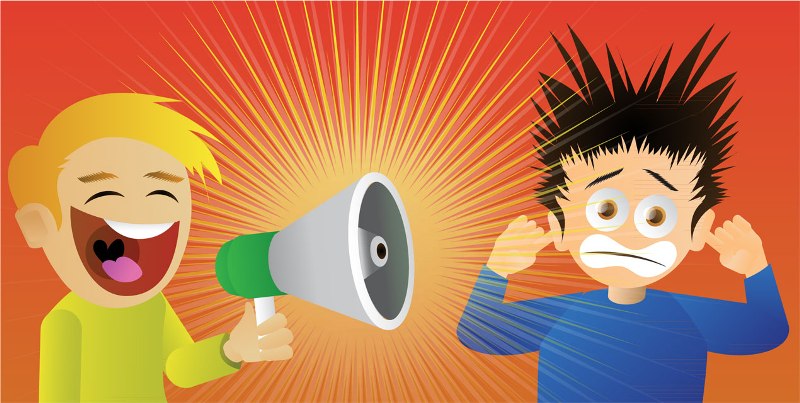“Śrīla Prabhupāda’s Kīrtana Standards,” installment 50

Over-loud amplification
Microphones and amplifiers can help make voices and instruments heard. But simply turning up the sound system full blast, making the kīrtana as loud as amplified rock music, may not be the best way to go.1 When the settings are at their best, the leader’s voice will not be louder than the sound of the devotees responding. Rather, those present will hear the leader singing with them as if at the same natural level. And the instruments, even if amplified, will never be so loud that they distract attention from the holy name.
But that’s not how the settings usually are. In Mayapur in February 1972, while Śrīla Prabhupāda was meeting with Bob Cohen (later Brahmatīrtha Dāsa), this exchange took place:
Prabhupāda: [loudspeaker is playing very loudly] Let them make a little soft. [break] [Laughter. The kīrtana or loudspeaker has stopped.] Great relief. [laughter]
Bob: I have felt that the loudspeakers were too loud all day.
Prabhupāda: Yes.
Bob: And I mentioned it to somebody.
Prabhupāda: It is pinching.
Bob: Yeah. It loses some maybe transcendentalism through the amplifier.
Prabhupāda: Yes, yes. Ask them to make it softer.
On August 10, 1977, Tamal Krishna Goswami recorded in his diary:
For more than a month, Prabhupada has had to ask daily that devotees not use the microphone for performing kirtana: “They think that their voice becomes sweet from using it. Actually, they sound exactly like a raksasa.”2
Blasting-loud kīrtanas may also damage people’s ears and cause permanent losses in hearing.3
By the way: The echo (reverb) feature of amplifiers takes sound already liable to be distorted by bad acoustics and distorts it further, making the acoustics still worse. As far as I know, Śrīla Prabhupāda never said anything about this. But devotees who know how to use amplifiers properly will nearly always set the echo to zero.
Amplifying both the singing and the response
Hari Śauri Prabhu reports that Śrīla Prabhupāda didn’t like both the lead and the response to be amplified:
[W]hen I was singing the noon arati at the Krishna Balarama mandir in Vrindavan, sometime during Sept. of 1975, before I became Śrīla Prabhupāda’s servant, I was the temple commander. I was leading the kirtan over the microphone, and because there were very few other devotees attending, I was also singing the refrain over the microphone. After a few minutes Upendra, who was Śrīla Prabhupāda servant then, came into the temple room and told me, “Śrīla Prabhupāda doesn’t like you singing the response over the microphone. Just sing the lead but not the response.” It was clear that he didn’t like the continuous use of the microphone.4
Akiñcana Kṛṣṇa Dāsa (a disciple of Dhanurdhara Swami who is a devoted kīrtana leader) has written me with a question.5 This incident, he says, shows that the same singer shouldn’t sing the lead and response. But what if a different person sometimes uses the microphone to sing the response? Wrong? For the noon aratrika kīrtana at the Kṛṣṇa-Balarāma Mandir in Vrindāvan, hundreds of guests visit and we want them to chant and dance. So sometimes, he says, it’s clearly practical to have someone sing the response into the microphone to help guide the guests. Is it possible Śrīla Prabhupāda wouldn’t be absolutely militant on this point?
On the other hand, Krishna Kshetra Swami has written me a related question, from another point of view.6 In some places, he writes, the continuous use of the microphone—whether in temples, or on parikrama, or anywhere—has become a common practice, with the leader using one mic, a single responder the other, or with one mic passed back and forth between them. Personally, he says, he finds this “highly annoying, if not downright offensive to the assembled devotees.” Kṛṣṇa, he explains, wants to hear all the devotees respond, not just one, and having one loudly amplified responder discourages the other devotees from even bothering to respond, or else they respond halfheartedly. The only purpose for having even the leader use a microphone, he writes, should be for everyone else to be able to hear what’s being chanted so they know how to respond.
So what can we say about Krishna Kshetra Swami’s concern and Akiñcana Kṛṣṇa’s question about “the problems of the microphone”? I have no direct answer from Śrīla Prabhupāda. But something Giriraj Swami has written provides sage guidance on these questions, and many others: “Prabhupāda wanted us to know–be convinced–that if we just followed his instructions, the process that he had given, all the problems would be solved. And we should apply such instructions intelligently, according to time, place, and circumstances—as Prabhupāda did.”7
Notes:
1 Measurements I took in 2014 with a sound-level meter showed that a typical kīrtana in an ISKCON temple, with the usual amplification, hovers at around 100 decibels, with a sustained crescendo of 106 to 110. This is roughly what you might get at a rock concert.
2 TKG’s Diary, p. 149
3 See “Noise-induced hearing loss” at https://www.jswami.info/hearing_loss/.
4 Email to Bhakti Charu Swami and others, April 1, 2007. (PAMHO text 13286976)
5 October 12, 2021.
6 Personal communication, October 10, 2021.
7 I’ll Build You a Temple, p. 422.

You must be logged in to post a comment.